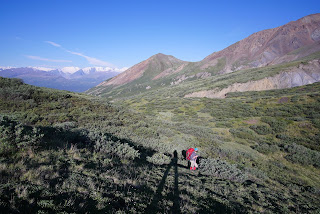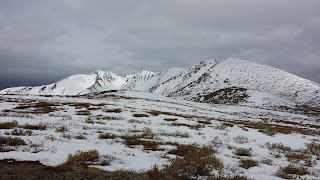 |
| My Delorme in Reach tracking map for the Donjek Glacier. Square images mark start and end points on the Alaska Highway as well as our six camp sites during the trek. |
From June 21 to 27 I hiked this
impressive wilderness route that passes by the terminus of the Donjek glacier. It is located mostly in Kluane National Park with the remainder on the traditional territory of the Kluane First Nations. Max from
Terre Boréale, a guide company in Whitehorse, Yukon, was my guide and companion for these seven awe-inspiring days.
We were the first ones on the Donjek route this year. When we registered at the Parks Canada visitor centre the warden was skeptical of our ambition to hike it in 7 days, as the normal time is between 8 and 10 days. Yet, permits in hand and undaunted we set out a little while later from the Alaska highway turnoff at the Duke River, just a few miles past Burwash Landing.
Day 1 - Burwash Uplands
We discovered quickly that the description we were using had a certain vagueness about it; but it did feature the occasional and very useful UTM coordinates which made route finding considerably easier.
 |
| Camp 1 in Burwash Uplands. (Click on pics to enlarge) |
The hike in from the road goes along an old mining road that most parties would drive up for 5+ km. We took that first hour as a warm up. Packs - filled with 9 1/2 days of food (just in case) and plenty of fuel, and the necessities for living in the wilderness - were at their heaviest, but the hiking felt easy.
We met some hail and then mere rain in the wide open Uplands. Our rain gear worked well and we eagerly continued on our way.
The hardest part came when we finally left the old mining road which had become faint in parts after about 16 km and hiked across a very hummocky tundra. Here the going was very slow and squishy. After a 9-hour day we found a perfect camp site near a creek that set us up well for the next day.
Day 2 - Hoge Pass to Donjek River
 |
| Max starts down the scree. |
We enjoyed an easy morning and a bit of a late start. Max and I were getting to know each other as hikers, and gauging how this day would set us up for either a 7-day trek or a longer one.
We entered the national park, had a short break near the Warden's cabin and then headed up toward Hoge Pass. We'd gain considerable elevation and then we'd descent a long scree slope to get to Hoge creek. Route finding here was tricky as the description didn't assist much and there were several ridges to pick from for the descent. Concerned about getting cliffed out we took our time to look at maps and landscapes, knowing full well, that since we couldn't see the whole route anywhere, we might well need to be prepared for some challenges. In the end, we plunged down a scree field for about 500 m elevation loss that featured some of the most challenging terrain I'd been on. Certainly, this was not the route described. Some sections where beautifully easy with mostly packed sand to plow through even if it was steep. But much of it had just that size rock on it, or was so hard packed that edging was impossible. I just focused on breathing and relaxing as I went.
When we got to Hoge Creek we found that water levels were lower than many others had warned us about. We crossed the creek only five (5) times and could rock hop, rather than ford it.
We put up camp where Hoge Creek meets the mighty Donjek river. This day was about 9.5 hours; even though that included a long lunch at Hoge Pass to enjoy the scenery and a few shorter snack breaks. Good nutrition is all important when pushing long days with heavy packs. Also eating meant the packs got lighter!
Day 3 - Donjek Glacier
 |
| Heading toward the bushwhack section (Photo by Max) |
This would be our easiest day of the whole hike. Just under 8 hours and we could hike along the Donjek river bed for a few hours before we needed to bushwhack up into the woods as the river filled the valley. We spent a couple of hours bushwhacking with the benefit of an old single track horse trail.
Day 4 - Donjek to Bighorn Creek
This was another easy day, spent sight seeing at the Donjek glacier, listening to it heave and break and watching large chunks of ice fall into the river.
 |
| Max and the glacier. |
 |
| Camp 3 - overlooking the glacier (Photo by Max) |
It was such a beautiful day and the hiking was easy. The biggest challenge for lunch was to find a bit of clear creek water for cooking. Many of the creeks on the map were in fact dry, or water would surface for short sections only to go underground again. We eventually found a nice lunch spot.
The ultimately biggest challenge of this day however was crossing Bighorn Creek in the afternoon. Its water ran high and it fell to Max to find good crossing spots. We spent over an hour navigating back and forth as we got cliffed out repeatedly.
I learned a lot about safely crossing fast moving, big waters; Max and I became a good team as we settled into our creek crossing grove.
We also decided to try the Bighorn Creek Canyon, a very narrow section, first thing the next morning when the water would be at its lowest. It had become clear, that it would be impassable otherwise (which would force us into a long detour via Expectation Pass) as the water rose by well over a foot through the day.
Day 5 - Bighorn Creek Canyon to Atlas Pass to Duke River
This was to become an epic day.
 |
Afternoon crossing of a very big Bighorn Creek. Way back,
that is Max stacking his stuff to come and cross with me. |
Our 4:50 am start saw me nearly 'eat it' within minutes in the frigid creek when the force of the water, still above knee high, and the rolling rocks conspired so that I lost my footing. Happily, I could grab Max' arm and got myself back up as he held on. Wow. I was all awake now!
We carried on, moved forward and just had to cross the creek one more time. Eventually I noticed blood running down my leg and my shin and knee ballooning with some large bruises. But since the water was so cold, I never felt a thing.
 |
Circling with the grizzly bears; they are in the background
at the edge of the plateau to the right of me. (Photo by Max) |
From here we headed up Chert Creek, where we changed out of our creek crossing shoes and warmed up with a 6 am breakfast and coffee!
By 8:30 am we had topped out at the plateau near the head of Chert Creek and promptly sighted a grizzly bear and her cup heading for us. We stayed calm as they were feeding and ended up circling toward us, while we circled out of the area. We had some amazing close views of both bears but were happy that they simply went about their business and weren't disturbed by our presence. We hiked up a ways toward Atlas Pass and took a break after all that excitement.
 |
| Nearing Atlas Pass (Photo by Max) |
Continuing upwards to Atlas Pass was beautiful as we moved through green hillsides and into the vegetation-free alpine. We gained about 1,000 m elevation by lunch.
And what a stunning place to have lunch!
Bonus: this was the first day the thick haze from forest fires cleared and we were able to see mountain ranges deep into
 |
| Lunch at Atlas Pass enjoying stupendous views. (Photo by Max) |
Kluane, toward the Icefield.
We had a nap after lunch to gather energy and our wits for an epic scree descent and long hike toward the Duke River. This descent was described in very precise detail, which suggested to us that there really is just one safe way down! We stuck to the description, including the Hole 9 green - it is quite something when you see that patch of green suddenly!
The descent and hike out toward the Duke river took about 13 hours. But then came the sprawling beaver ponds along the Duke. We got wedged in on the mossy, wet and steep forest side and we ended up bushwhacking for an
 |
| Heading up on Atlas Pass to get to scree entry. (Photo by Max) |
hour before deciding to cross the beaver pond in search of dry land. Happily Max found just that and 14.5 hours after the day's start we set up camp and contemplated the fact that we were indeed moving at a very fast pace and would get back to the Alaska Highway and our van well within 7 days!
Day 6 - To Copper Joe Creek
This day was supposed to be a normal hiking day: cross the Duke in a safe spot, hike along it for a few more kilometers and then head up to the saddle and drop to Cache Lake to camp.
 |
Me on that last bit of vertical scree.
The key: just keep on moving fast!
(Photo by Max) |
Well, it got a little more interesting when we couldn't locate the 'faint path' that was once a mining road and instead bushwhacked through thick brush from the river to the saddle. Max' way-finding made sure we kept moving forward and upward with purpose; handily dispensing with the willows and shrubs and stopping for the views when we came out of the woods. We got to Cache Lake early enough to just take a break and then hike along Copper Joe Creek to gain a little time on our last day. Unfortunately, the creek bed was completely dry! So rather than going just a little further we ended up with a bit of a hike as our water supplies dwindled.
We were happy to get to the first sign of water in that creek quite a ways down and set up our final camp.
Day 7 - to the Highway
We didn't have much hiking left to do and reached the highway by noon. Unlike other people, we had our one vehicle on the other side of Burwash Landing about 15 km along the Highway. With no luck hitchhiking we ended up walking nearly into Burwash before a truck stopped and we jumped in the back. This made very short order of those final 10 km.
 |
| Duke River vistas. (Photo by Max) |
They say this is a serious wilderness route and it is: impressive creek crossings (even as we had quite low flows for some of them), fantastical mixed scree descents off Hoge and Atlas passes, bushwhacking through thick vegetation (thankfully sometimes aided by game trails and an overgrown horse trail) and finding your own way in a truly wild and remote place. This trek has it all and demands it all.
Next up: more Yukon mountain excursions and then the Andes and an attempt on Aconcagua. (I hope!)












































